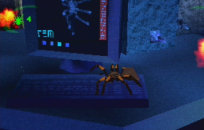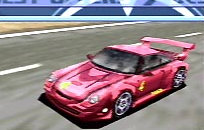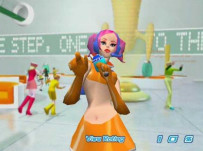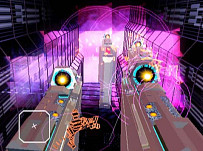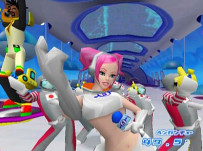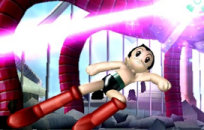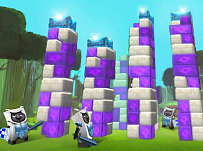Jake Kazdal
An American Gaijin

COREgaming
- 16 / 09 / 08
I. ON THE FRONT LINES OF INNOVATION
Like so many other avid and young videogame players around the world, Jake Kazdal felt deeply fascinated by the communicative potential of the videogame medium from the very first moment. The interactivity of the experience between player and program was essential in his life pursuit of one day being able to contribute to the larger effort. While this outline could easily describe the motives supporting most emerging videogame personalities, the majority of cases will likely pale in comparison to Kazdalís merited accomplishment. He is the kid who used to play for quarters, like so many of us, and ended up ascending to one of main the cores of videogame creativity in the industryís holy land in Japan.
One of the most impressive sides of Jake Kazdalís career can only be understood bearing in mind how rare it is for westerners to penetrate the Japanese world of creativity, down to its centermost core where the revolutionary ideas are forged. While some eastern companies have contracted western minds in order to achieve certain objectives, for instance when Nintendo of Japan approached the small British studio Argonaut, SEGA of Japan earned a reputation for being somewhat impenetrable. As Kazdal so fluently describes his website resume, he was the only non-Japanese worker in the Tokyo division of SEGA, one of the most powerful and inventive clusters in the country, for the period of four years.
In his younger days, Kazdal felt deeply mystified by the pure gameplay challenge that videogames offered. When he studied in high-school, he was living down the street from the Nintendo of America building, a proximity that enabled him to find his first job as a videogame counselor - testing new videogames before their public distribution. In a market so rapidly expanding, large companies like Nintendo opened their doors to talented and dynamic young people in order to lend a helping hand. Later associated with the North-American divisions of IREM and Enix, he attended Art and Film school classes where he acquired the expertise needed to become involved in the process of videogame making.
One of his first experiences was level design and polygon modeling for the obscure Playstation game SPIDER, just as he moved to Boss Game Studios Inc. In a fortunate occasion, he met with an Alias Systems Corporation representative Kenneth Ibrahim, who noticed the SEGA toys scattered all over his desk. After confessing his admiration for the company to this ex-AM3 programmer, who had previously donated his vocal talent for the co-pilot voice in SEGA RALLY, he proposed that Kazdal should meet with SEGAís own prodigal son Tetsuya Mizuguchi - an encounter that would take place in Japan some time after.
Mizuguchiís easy going and friendly personality allowed for a great understanding between both, an enduring relationship which still lasts to this date. Because this SEGA giant was recruiting new members to form a new SEGA subsidiary group, United Game Artists, Kazdal was later invited to be a part of the show.
The project where he first participated was, simultaneously, UGAís debut title for the newly released Dreamcast console. SPACE CHANNEL 5 was from its early days a new standard in innovation for music-based games, while presenting stylish and idiosyncratic kitsch visuals that caused a considerable impact on the players.
The spotlight, however, would be centered in its female protagonist Ulala, the sexy space reporter that salvaged the galaxy from an alien threat with her exceptional dancing skills. Unlike the majority of rhythm-based games, UGAís premiere title was based on a quirky narrative that, together the diversity of music styles evoked the space-age science fiction lore in a unique and matchless fashion.
In spite of SPACE CHANNEL 5ís severe attempts to strike videogame conventions, with all its glamour and innovative character, UGAís brainchild was already entering its production phase: the 2001 misconstrued title REZ. While the majority of critics recognized the game for its sheer audiovisual grandeur, it proved to be far ahead of its time. Surprisingly, the same sources that once acccused UGA's game to be a failure are now referring to it as a landmark of game design, namely with the reissue of the game in high definition format for the XBOX 360.
With the pitiful advent of SEGAís dissolution, mostly as a consequence of the poor results attained in the hardware market, UGA still had time for a last cry in the form of SPACE CHANNEL 5: PART TWO, a sequel to the original game that was far more substantial, while retaining the audiovisual delight first essayed in 1999. Kazdalís active part as a character designer, conceptual artist, modeler and animator in these treasured games would be followed by a significant participation in SEGAís ASTROBOY, for the PS2, as well as an unknown GameCube project, just cancelled before he left the Japan and returned to his country.
Motivated by the perspective of learning and improving his skills, Jake Kazdal somehow managed to find balance. Despite his professional downfall, his career continued in Zombie VR Studios in 2003, and later in Electronic Arts in 2006, after studying Industrial Design and Illustration in the Pasadena Art Center College of Design. In his website, JKOOXL Design, he displays some of his finest work in his Portfolio. His most recent compositions can be seen in the acclaimed title BOOM BLOX for the Nintendo Wii: the first release from a rumored three game contract between EA and Steven Spielberg.
Like every dream that must end, his unique experience in Japan provided him the growth he needed, a time and a place where he made friendships still consolidated to this day. Apart from that, he also helped to create some of videogameís most memorable experiences, not in the role of the designer or the producer, but with a valid contribution that underlines the vision and effort of those who often appear in the bottom of the credits list. At this level of production, videogames are essentially the result of a team work, where every individual's support produces a difference seen in the final result.
Videogame Works SPIDER (1996, Playstation)
After a dramatic lab accident, a scientist's mind is transported into a robotic, spider-like body. An interesting mixture between platform and shoot'em up elements that resembled, at times, the cult classic BAD MOJO. Extreme Edge: Twisted Snowboarding (1998, Nintendo 64)
The usual snowboarding game, featuring utopic snow courses and gravity defying stunts. Kazdal's work in Boss Game Studios, and in this game in particular, was mostly related to level and texture mapping design. World Driver Championship (1999, Nintendo 64)
A late N64 racer, World Driver Championship was a visually impressive game whose gameplay was only above average. Space Channel 5 (1999, Dreamcast)
One of the most inspired games ever, Space Channel 5 is an exercise in style, fashion and grace. Like other games before it, the gameplay is based on repeating key patterns associated with body movements. The game's main attraction, space reporter Ulala, was created with the help of Kazdal's talent. Rez (2001, Dreamcast)
Rez is, for certain, one of the few games which no game player or modern art lover should miss. Apart from its gorgeous presentation, audiovisual thrill and pulsating rythm, Mizuguchi's masterpiece is a convoluted enigma. Space Channel 5: Part 2 (2002, Dreamcast)
A surprising sequel that kept the same funky vibes from the original game, while adding an improved game play experience and a whole new soundtrack. Astro Boy (2004, Playstation 2)
At a time of internal structure reorganization at SEGA, Kazdal still had the chance to work in Osamu Tezuka's classic manga game license, Astro Boy, developed at Sonic Team. With its faulty gameplay, this title reflected the climate of disarray the japanese gaming giant was going through. Boom Blox (2008, Wii)
Bloom Blox is the critically acclaimed Steven Spielberg puzzle game design where physics and building blocks play the central role. Kazdal worked in the main team, providing additional artwork for the project.
|


